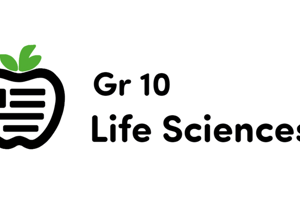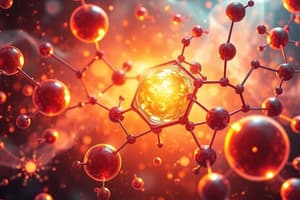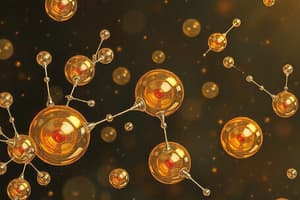Podcast
Questions and Answers
What is the primary difference between elements and compounds?
What is the primary difference between elements and compounds?
- Elements can be broken down into simpler substances, while compounds cannot.
- Elements are only found in nature, while compounds are synthetic.
- Elements are made up of one type of atom, while compounds are made up of multiple different atoms. (correct)
- Elements consist of multiple different atoms, while compounds consist of only one atom.
The atomic number of an atom is determined by the number of neutrons it contains.
The atomic number of an atom is determined by the number of neutrons it contains.
False (B)
What do we call atoms that have the same number of protons but different numbers of neutrons?
What do we call atoms that have the same number of protons but different numbers of neutrons?
Isotopes
The mass number of an atom is the sum of ________ and ________ in its nucleus.
The mass number of an atom is the sum of ________ and ________ in its nucleus.
Match the following subatomic particles with their characteristics:
Match the following subatomic particles with their characteristics:
Which of the following statements about ionic bonds is true?
Which of the following statements about ionic bonds is true?
The pH scale measures the concentration of hydrogen ions in a solution.
The pH scale measures the concentration of hydrogen ions in a solution.
What does the conservation of mass principle state?
What does the conservation of mass principle state?
What pH range indicates a strong acid?
What pH range indicates a strong acid?
All bases feel slippery and have a sour taste.
All bases feel slippery and have a sour taste.
What ion does an acid release in an aqueous solution?
What ion does an acid release in an aqueous solution?
A substance that turns red litmus paper blue is classified as a __________.
A substance that turns red litmus paper blue is classified as a __________.
Match the following substances with their examples:
Match the following substances with their examples:
Which of the following acids is commonly used in fertilizers?
Which of the following acids is commonly used in fertilizers?
Flashcards are hidden until you start studying
Study Notes
Compounds vs. Elements
- Atoms can form molecules or crystal lattices.
- An element consists of only one type of atom or molecule.
- A compound contains multiple types of atoms or molecules.
Parts of an Atom
- Atoms consist of three subatomic particles: protons, neutrons, and electrons.
- Protons and neutrons are clustered in the nucleus, while electrons move rapidly in an electron cloud surrounding the nucleus.
Atomic and Mass Numbers
- The atomic number is determined by the number of protons in an atom's nucleus, defining the element.
- The mass number is the total of protons and neutrons in the nucleus.
- Electrons in a neutral atom equal the number of protons.
Isotopes
- Isotopes are atoms with the same number of protons but different numbers of neutrons.
Ionic Bonds
- Ionic bonds form when one atom donates electrons to another.
- The donating atom becomes positively charged, while the receiving atom becomes negatively charged.
Types of Chemical Equations
- Written equations express chemical reactions using words.
- Symbol equations express reactions using chemical symbols.
Conservation of Mass
- Mass is conserved in chemical reactions; initial mass equals final mass.
pH Scale
- The pH scale measures acidity or basicity, calculated as pH = -log[H+].
- Acids have a pH of 0-7 (stronger with lower values).
- Bases have a pH of 7-14 (stronger with higher values).
- Acids produce hydrogen ions [H+] in aqueous solutions.
- Bases produce hydroxide ions [OH-] in aqueous solutions.
Characteristics of Acids
- Sour taste and corrosive nature.
- Turns blue litmus paper red.
- Reacts with metals to produce hydrogen gas.
- Conducts electricity.
- Strong acids have a high concentration of hydrogen ions, while weak acids have a lower concentration.
Characteristics of Bases
- Bitter taste and slippery feel.
- Turns red litmus paper blue.
- Caustic and can burn living tissue.
- Strong bases have a high hydroxide ion concentration; weak bases have a lower concentration.
Examples of Acids
- Carbonic acid (H2CO3): found in soft drinks and seltzer water.
- Hydrochloric acid (HCl): present in stomach acid.
- Nitric acid (HNO3): used in fertilizers and explosives.
- Sulfuric acid (H2SO4): common in car batteries.
Examples of Bases
- Aluminium hydroxide (Al(OH)2): used in antacids and deodorants.
- Calcium hydroxide (Ca(OH)2): found in plaster and lime.
- Sodium bicarbonate (NaHCO3): known as baking soda.
- Sodium hydroxide (NaOH): found in cleaners and lye.
Acid Reactions
- Acids can corrode metals, forming salts and hydrogen gas.
- In this context, "salt" refers to any compound formed from the reaction of an acid with a base, not just sodium chloride (NaCl).
Studying That Suits You
Use AI to generate personalized quizzes and flashcards to suit your learning preferences.




